Newsletter - September 2016
Burlington Historian

September 2016

The Wreck of the “Edmund Fitzgerald”
Best-selling author and speaker Rochelle Pennington will return to Burlington on Sunday, December 4, 2016, to present her program on the “Edmund Fitzgerald,” the largest shipwreck ever to go down on the Great Lakes. The program, scheduled to start about 1:30 p.m, will be held at Veterans Terrace at Echo Park. Doors will open about 1:00 p.m.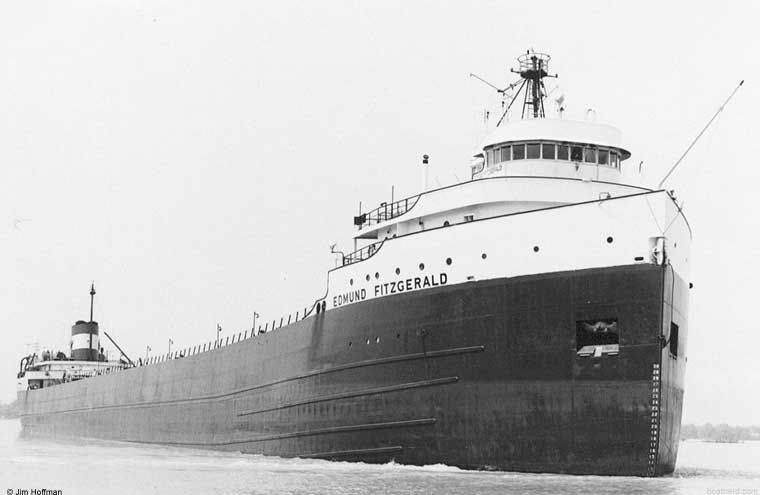
No other Great Lakes shipwreck is more well-known than the “Fitzgerald,” which disappeared into a stormy Lake Superior on November 10, 1975, when wind gusts peaked at nearly 100 miles an hour and waves reached the height of a 3-story building.
The sinking of the “Fitzgerald” may have become the Great Lakes most well-known wreck because of Gordon Lightfoot’s haunting ballad about the wreck. The song sold millions of copies immediately after the vessel’s loss.
Ms. Pennington will delve into the history and mystery of the vessel (shown in the accompanying 1973 photo by Jim Hoffman of the Marine Historical Society of Detroit) and will explore the opposing views of dive detectives who are still trying to determine what led to the demise of the 29-man crew.
The massive ore freighter, built and owned by Milwaukee’s Northwestern Mutual Life Insurance Co., was named after its president, Edmund Fitzgerald.
Launched in June of 1958, the “Fitzgerald” primarily hauled iron ore pellets, which were picked up at the docks in northern Minnesota. The ship’s usual route was from the far western end of Lake Superior, through the Soo Locks, then south to the steel mills in Detroit, Michigan, and Toledo, Ohio. on the lower lakes. The “Fitzgerald” logged over a million miles in this way during its short life.
Audience members will be led from the ship’s launch to its final radio broadcasts, and from the discovery of the sunken ship on Lake Superior’s bottom to the location of the vessel’s artifacts in various museums.
The talk, free and open to the public, is sponsored by the Burlington Historical Society, which will hold a short business meeting before the program. Light refreshments will be served.
President’s Message
Fast summer, fast year. It's been sort of a quiet time for our Society recently. We did complete some needed repairs to the Whitman School House on the south side of town. A new roof was installed and all windows replaced. We hope to get activity with some scheduled tours of the facility in the near future to show students of today what a one room school house experience would have been like a hundred fifty years ago.
We held our annual Ice Cream Social at the end of July in Wehmhoff Square in conjunction with the Chamber of Commerce’s "Sidewalk Sales Days." The weather was the best we’ve had for years but the park was not overcrowded.
Some of the historic buildings in Burlington have been refurbished recently, including the former Krein’s Color Bar on Pine Street at Milwaukee Avenue. Its new owner is converting it to a restaurant and drink establishment. With the help of the Society’s extensive historic photo archives, the new owner is trying to keep the building’s facade close to the look it had when it was the Schuette-Daniels Furniture Store.
The Board of Directors welcomes its newest member, Tim Beix, who is a Burlington native and local history buff. He is active in community activities, including the Burlington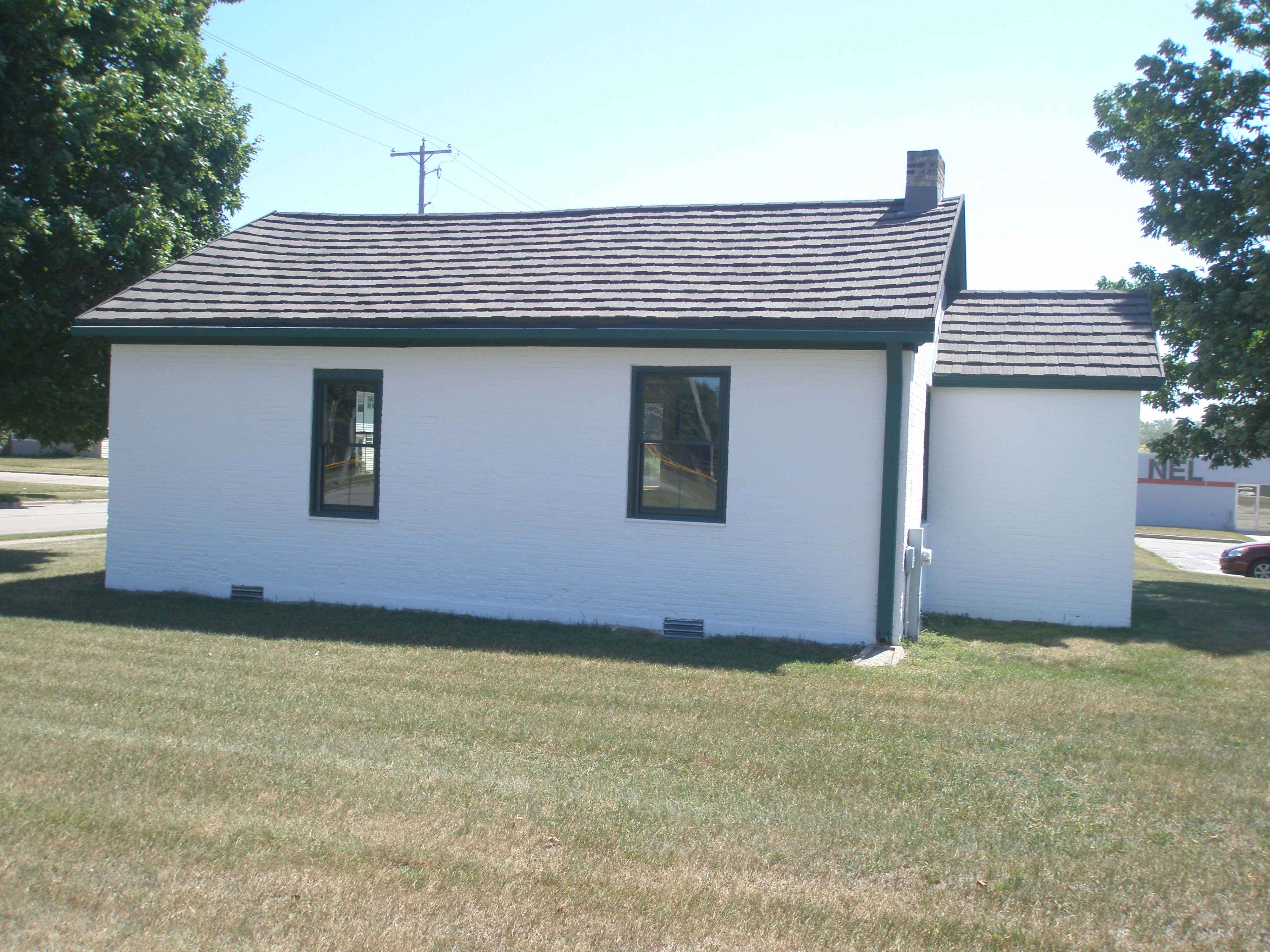 Lions Club. As I have mentioned before, the Society Board of Directors is looking for additional help at the museum and log cabin. Please spread the word around to other history buffs in the area that may want to spend an hour or so each month getting involved in our activities for the public.
Lions Club. As I have mentioned before, the Society Board of Directors is looking for additional help at the museum and log cabin. Please spread the word around to other history buffs in the area that may want to spend an hour or so each month getting involved in our activities for the public.
I'm looking forward to a "cool-down" and a refreshing fall season that is approaching. Enjoy the rest of the season.
Dennis Tully
Whitman School Improvements
Whitman School – the Society’s 1840 one-room school house in Schmaling Park on Beloit Street – has undergone a substantial refurbishing, as shown in the accompanying photos. In addition to the carpentry work described in the June newsletter, Ehlen Masonry tuckpointed the brick and Jamco Painting cleaned and painted the exterior. Some interior work remains to be completed.
A Summer Trip in 1926
The following is excerpted from a letter that Amanda Cady Webley, who was born near Lake Geneva, sent to a niece in Missouri in 1926.
. . . So often I have thought of sending your mother a snapshot or something and then comes the thought what good would it do when she cannot see. Perhaps she might be interested in hearing about our trip this summer.
We traded our old Ford sedan in on a new Chevrolet coupe, a pretty French gray, with balloon tires, bumper, etc. Then we packed our tent and army cots, dishes, camp stove, food, etc. and drove 450 miles up to Minnesota.
We first went to Lake Osakis and camped in the tourist park, which is very pretty. We thought that it would be fine on the bank of the lake where we could go in bathing most any time, but it was so cold that we never went in once and the wind made the waves so high that it was too rough to enjoy rowing.
So we pulled up and went down to Glenwood where Mertia Cady Caley lives and camped in the park there on the bank of Lake Minnewaski, which is even longer than its name and quite pretty. We had some nice bathing here and caught some fish.
We came home by the way of Sioux Falls and saw some fine scenery, visited a rock quarry where they make crushed rock and where there are miles of rock standing as if to make into a stone wall. It was 102 in the shade the day we came home and we had hard work to keep awake driving. We got home tired but did not have time to get rested till we went to the fair in Des Moines, Iowa. We had charge of an exhibit there and stayed two weeks.
We then expected to come home but it began raining and it seemed to forget to stop. The roads in some places were impassable so we did not come home but kept on the gravel roads and worked towards home stopping at several places in a day. We were nearly a week on the road staying at hotels this time as we did not have our camping stuff. I was very glad to get home but have been very busy since as I canned a lot of fruit and had the house cleaning and extra washing etc. I do quite a lot of sewing for other people but have visions of getting our own work done before I begin anything for others but it was only a vision. They begin coming before I was half ready. . . .
Webley (Amanda’s husband) is on the road all the time and is doing very well. He had the back of the new car fixed to carry an electric washer, which is one of the things that he sells. There is a nice cover over the machine just like the top of a car so the car looks as if it had a rather bad curvature of the spine. When he gets this machine introduced, he can have the car put back as it was. He sold nearly $60,000 last year and hopes to do better this year as the territory has not been worked for several years before he took it. . . .
Love and best wishes to all,
Aunt Amanda
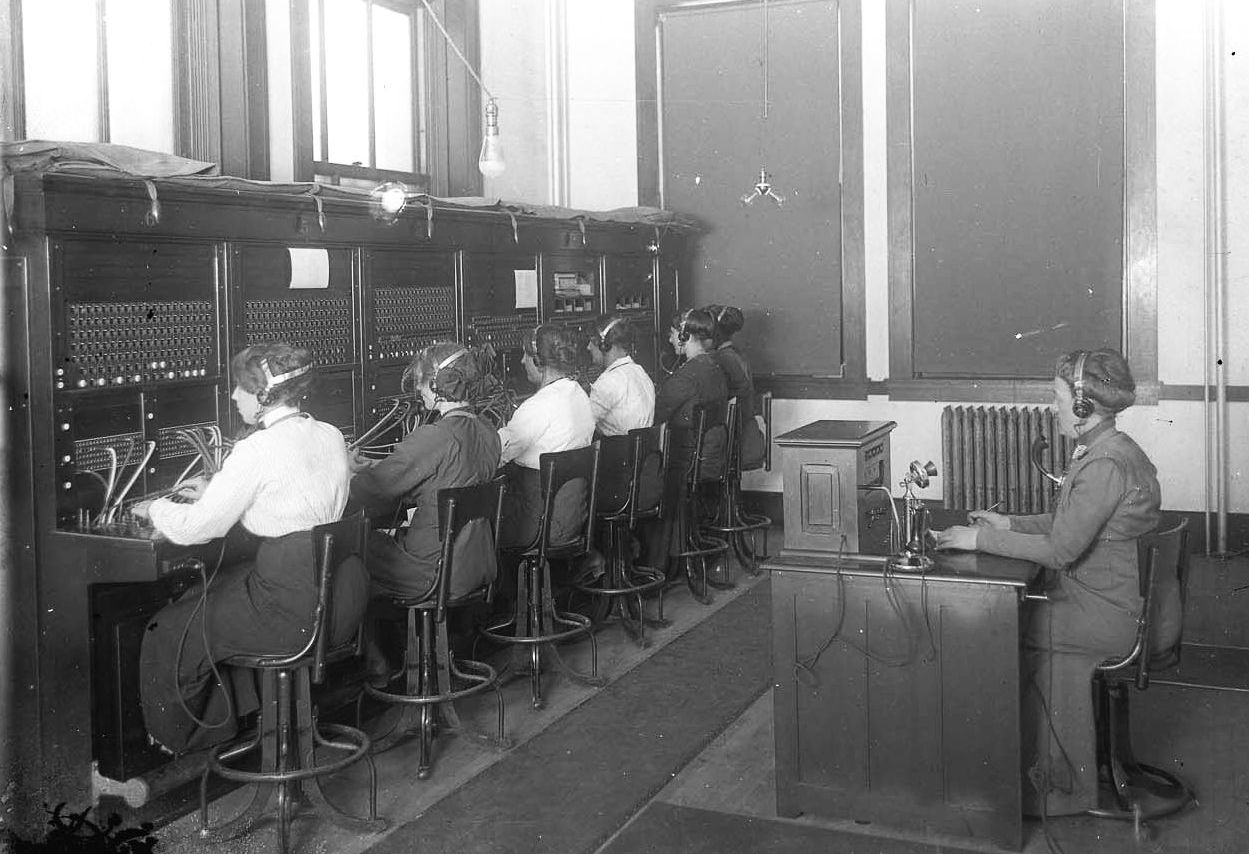
Telephone Talk
In October 1937 the Wisconsin Telephone Co. office in Burlington reported that its 15 operators had handled more than 5,800 local and 300 long distance calls daily during the previous month.
The Wisconsin Telephone Co.'s Burlington operations
were in the basement of the Bank of Burlington (now
May’s Insurance) building from 1913 until 1956.
(From Howard Wood glassplate negative, circa 1915)
September!!
By Priscilla Crowley
What does September mean? September means lots of different things – it means soon summer vacation will be over and children will be heading back to school for another year of learning and yellow school buses will become part of the traffic pattern in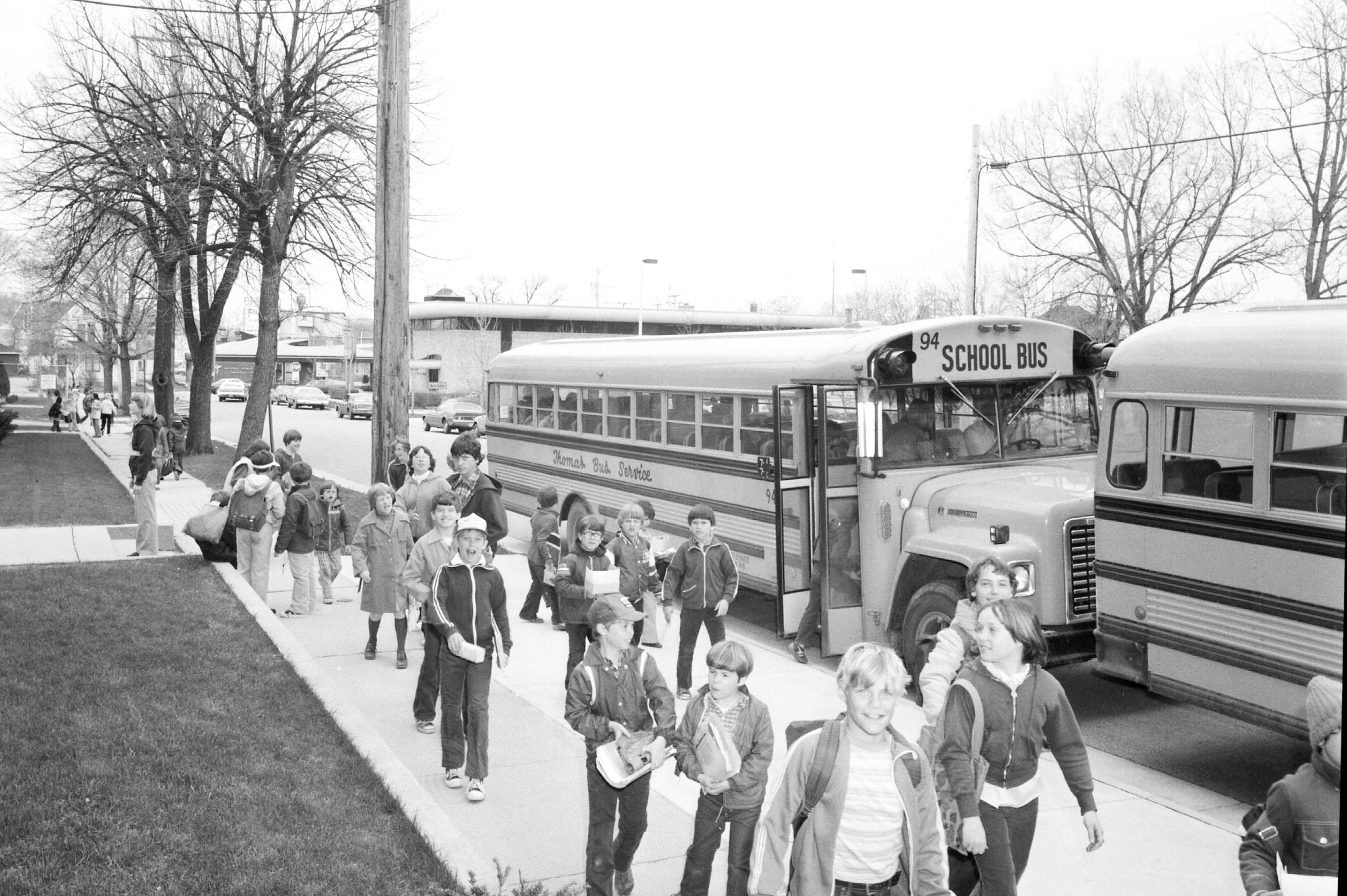 the morning and afternoon. For kids at least, it means the end of sleeping late and those lazy summer days when you have nothing but time, no fixed agendas, no time lines, no worries about homework, teachers, or schedules. For adults, especially parents, it means getting ready for the start of another school year, new clothes, new school supplies, new teachers, sometimes a new school, a different schedule, and the challenge of getting everyone up, dressed, fed, and off to school on time with all of their books, papers, homework, lunches, and everything else necessary to get through the school day. For teachers it’s prepping their classrooms for a new set of students, getting lesson plans and desks, bulletin boards, name tags, and the million and one other details needed to successfully launch another class of students into the new year.
the morning and afternoon. For kids at least, it means the end of sleeping late and those lazy summer days when you have nothing but time, no fixed agendas, no time lines, no worries about homework, teachers, or schedules. For adults, especially parents, it means getting ready for the start of another school year, new clothes, new school supplies, new teachers, sometimes a new school, a different schedule, and the challenge of getting everyone up, dressed, fed, and off to school on time with all of their books, papers, homework, lunches, and everything else necessary to get through the school day. For teachers it’s prepping their classrooms for a new set of students, getting lesson plans and desks, bulletin boards, name tags, and the million and one other details needed to successfully launch another class of students into the new year.
To a teacher the start of a new school year is like taking on a new family. You know you have lots of different personalities walking through your door, you know their names, you can read their files but a file doesn’t tell you everything about an individual student. It may tell you that this boy has problems with reading or math or that this girl has problems with comprehension but what that file can’t tell you is how these children are going to get along with each other. Some years you may get a class which can’t figure out how to line up and other years you have a class that has it all figured out – sometimes you have students whose best behavior is only having to be sent to the office twice a week or you have a class who has problems figuring out multiplying double digits and sometimes you have a student who is so far ahead in math that you can barely keep up with him. You just never know. I sometimes think that teachers must be gamblers at heart because every year they roll the dice and take a chance on what will walk through the door and there is no predicting exactly what kind of roll of the dice you will get.
I know that parents often think that schools go dormant in the summer – no activity – no teachers – nothing going on. The exact opposite is true. There is a constant flow of people in and out of all the schools during the summer – cleaning, repairs, teacher meetings, summer school, classes for teachers, and prep work and planning for the upcoming year. While it’s true that the summer schedule is a more relaxed schedule, it is still an extremely busy one. Everything is geared towards one thing – the first day of school.
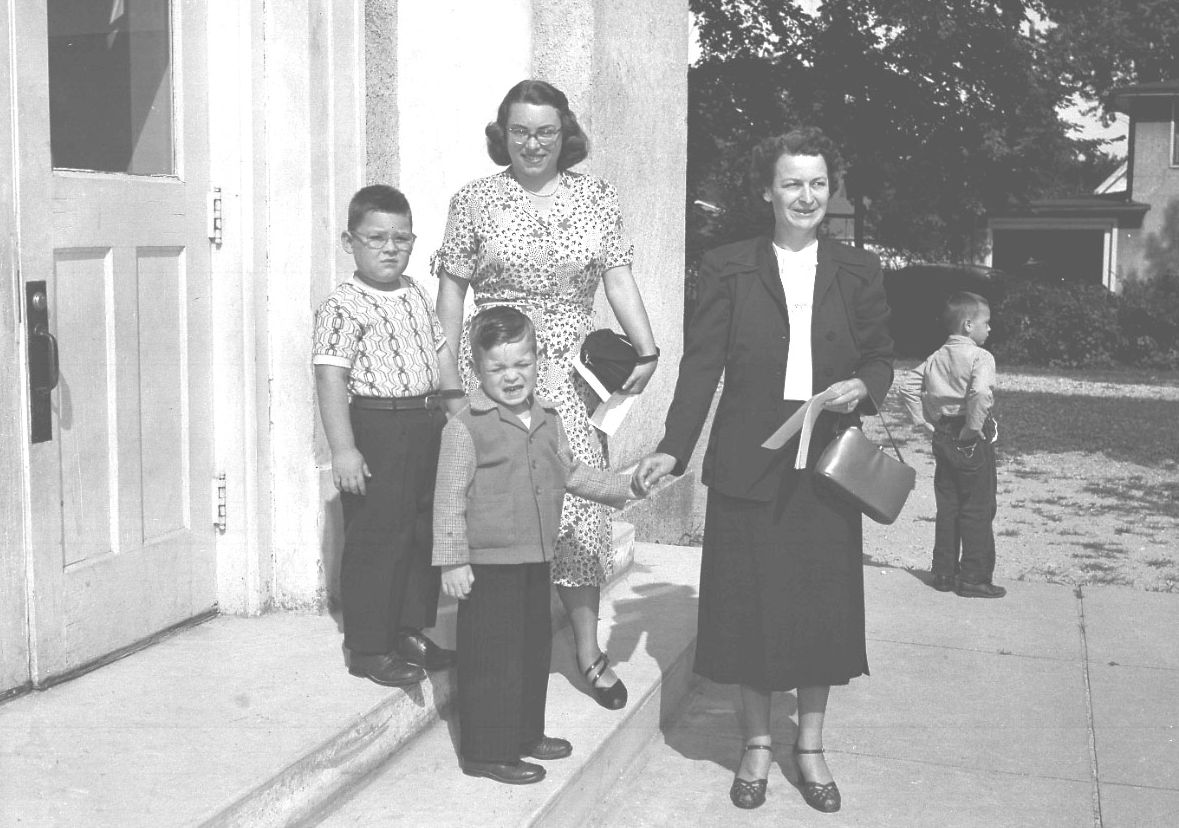 Remember the first day of school? I don’t know about anyone else, but I do know that I hardly ever slept well the night before school started. A child starting back to school looks at the first day a little differently than a staff member does. For a child the first day can produce wide-eyed excitement and wonder or a sense of doom and gloom and how soon can I get out of here? When is Christmas vacation again?
Remember the first day of school? I don’t know about anyone else, but I do know that I hardly ever slept well the night before school started. A child starting back to school looks at the first day a little differently than a staff member does. For a child the first day can produce wide-eyed excitement and wonder or a sense of doom and gloom and how soon can I get out of here? When is Christmas vacation again?
I spent many years working as either a Teacher Aide or a School Secretary and you just couldn’t beat the first day of school. The excitement level was always through the roof. Chaos reigned supreme – parents and children all eagerly entering the building, teachers trying to corral their students, buses dropping students off, kindergartners trying to figure out where they were supposed to go and looking so little and cute and confused and scared all at the same time. It was “all hands on deck”; everyone had bus duty or hall duty or both. It always took me by surprise how quiet everything got the minute the final bell rang and everyone was in a room – it wasn’t always the right room, but they were all in a room.
In my days as a Head Secretary, it was my responsibility to sell lunch tickets every day. The first day of school was a riot. The teachers would bring the classes in one by one and I sold tickets until everyone had what they needed. Of course, at that time kindergarten students only went half days so no lunch for them but the first graders were another matter altogether. Not only were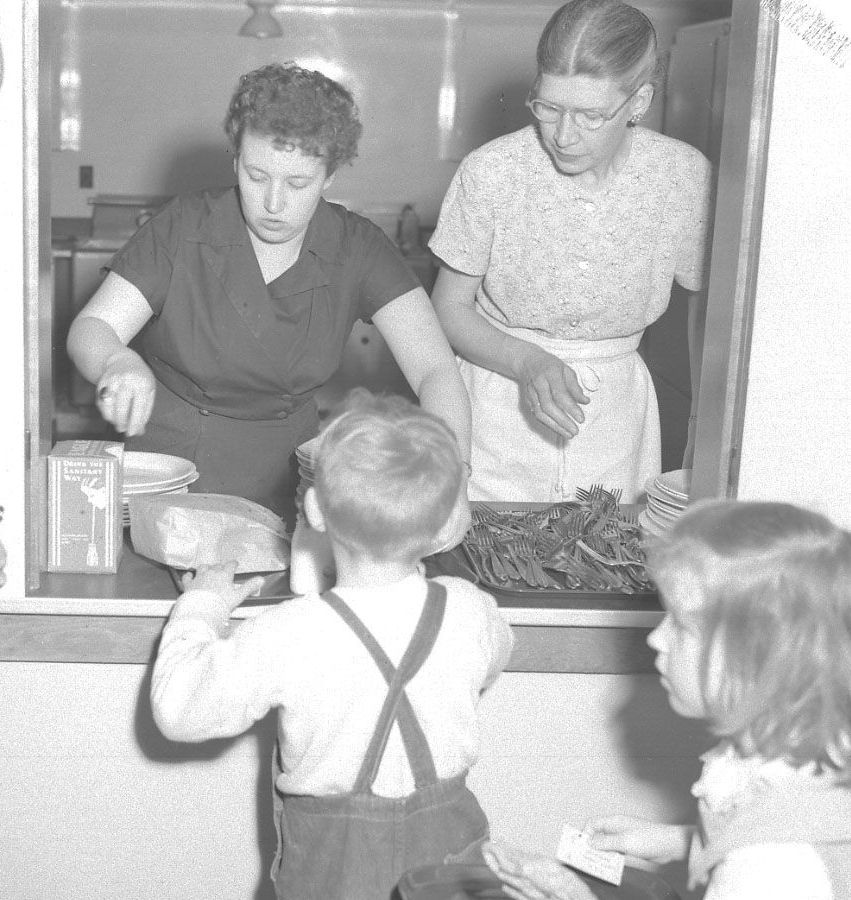 they in first grade, it was their first experience in buying lunch tickets. They absolutely had no clue as to what was going on. If Mom was really organized and sent a note with her child and the exact amount of money or wrote a check, you could easily figure out what kind of lunch ticket a child needed. If a child came with no bag lunch and no money – that produced a different kind of a scenario and most times asking the child didn’t produce anything more than a shrug of the shoulders and an “I don’t know – Mom didn’t tell me, but I think I’m supposed to eat.” I can honestly say no child went hungry – one way or another everyone who needed a lunch got a lunch.
they in first grade, it was their first experience in buying lunch tickets. They absolutely had no clue as to what was going on. If Mom was really organized and sent a note with her child and the exact amount of money or wrote a check, you could easily figure out what kind of lunch ticket a child needed. If a child came with no bag lunch and no money – that produced a different kind of a scenario and most times asking the child didn’t produce anything more than a shrug of the shoulders and an “I don’t know – Mom didn’t tell me, but I think I’m supposed to eat.” I can honestly say no child went hungry – one way or another everyone who needed a lunch got a lunch.
If you think the start of the first day was chaotic, you really need to be there for the end of the day. Again, everyone is on bus duty – you need to sort out whether they are bus students, walking students, or is Mom or Grandma or Dad or someone else coming to pick this child up and take them home. Do any of the students ride an early bus? – whatever you do, don’t miss the early bus. About twenty minutes after school is dismissed, the calls start to come in – frantic parents looking for their children. This doesn’t happen too often with the older students – they are old hands at this bus business, but the little ones are a different matter altogether. Everyone outside has a copy of the bus list and the kids are supposed to have nametags on so the staff can match the student with the right bus and most of the time that works really well and everyone gets on a bus – the majority of the time it is the right bus. A huge sigh of relief from everyone involved is given when the last bus pulls away from the school and there are no left-over children and everyone has been put on a bus, picked up by a designated person or has walked home with older siblings. It’s always a good sign when there is no one left crying in the office because they aren’t sure where they are supposed to be and they just want to go home! No system is perfe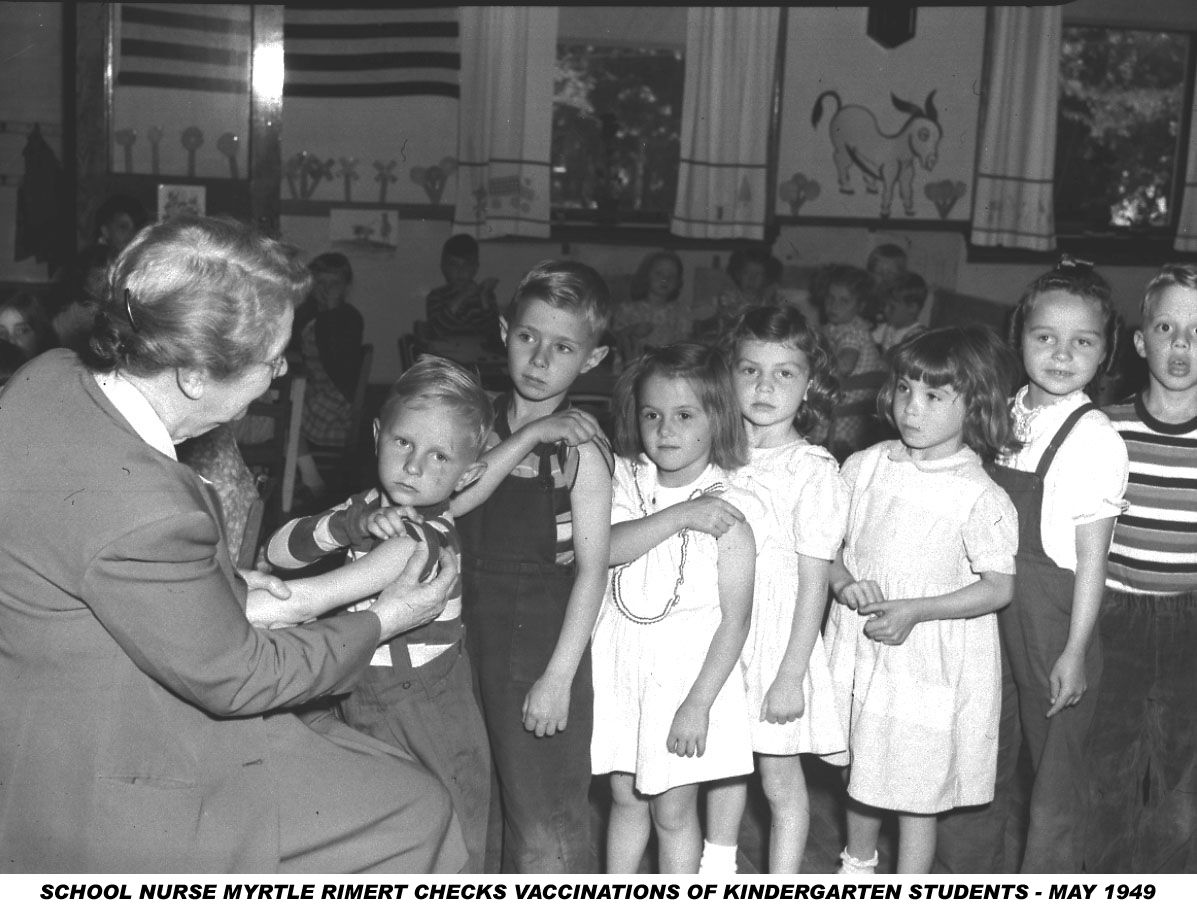 ct – as hard as everyone tries, mistakes do happen but when you look at the number of students being dealt with, it’s amazing how well everything goes. Within 2 weeks everyone settles into a routine and they all pretty much know where they are supposed to be – of course, there are always exceptions to that rule. Every rule seems to have an exception.
ct – as hard as everyone tries, mistakes do happen but when you look at the number of students being dealt with, it’s amazing how well everything goes. Within 2 weeks everyone settles into a routine and they all pretty much know where they are supposed to be – of course, there are always exceptions to that rule. Every rule seems to have an exception.
The best part of the first day is that the next day everyone gets to do it all over again. How much fun is that? School plays a huge part in everyone’s life. The memories that are created during our school days stay with us throughout our lifetime. It’s another chapter in our book of life. I have not been in a school as a Head Secretary in a number of years but the first day always brings back the memories of all the “first days of school” I have gone through both as a child and an adult. I wouldn’t trade those memories for anything. When your children or grandchildren come home on the first day, take the time to listen to their stories about their triumphs and their stories about what didn’t go as well. Everyone loves to share and a burden shared is not as heavy and a shared triumph is twice as sweet. Listening to the children will only help to bring back all of your memories of your “first days.” Enjoy!
Two Thankgivings
In 1939 President Franklin D. Roosevelt broke with a 75-year tradition started by President Abraham Lincoln’s 1863 declaration that the last Thursday in November be a day of “thanksgiving and praise.”
Because the last Thursday of November 1939 was going to be November 30, retailers complained that this left only 24 shopping days to Christmas. So FDR declared Thanksgiving to be November 23, the second-to-last Thursday of the month.
Many governors did not agree with FDR's decision and refused to follow him. The country became split on which Thanksgiving day should be observed. Twenty-three states followed FDR's change and 23, including Wisconsin, did not. Two states, Colorado and Texas, decided to honor both dates.
In 1940, FDR again announced Thanksgiving to be the second-to-last Thursday of the month. This time, 31 states followed him with the earlier date and 17, including Wisconsin, kept the traditional date. The confusion over having two Thanksgivings continued.
Although Lincoln had established the Thanksgiving holiday to bring the country together, the confusion over FDR’s date change was tearing it apart. On December 26, 1941, therefore, Congress passed a law declaring that Thanksgiving would occur every year on the fourth Thursday of November.
